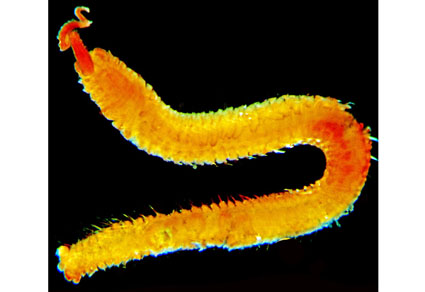Abstract
A new shell-boring spionid polychaete of the genus Dipolydora is described from the gastropod, Kanoia meroglypta (Family Trochidae), collected from mussel beds on the continental slope off Louisiana at a depth of 617 m in an area of methane seepage. The new species belongs to a large group of Spionidae comprising the Polydora complex (ca. 178 species) having a modified setiger 5. The new species, Dipolydora walkerae sp. nov., belongs to a small group of Dipolydora having large hooked spines on setiger 5 surmounted with a crest or cloak of fine bristles or fibrils and has posterior notopodia with modified acicular spines. The majority of polydorins are from intertidal or continental shelf depths; deep-water accounts are few and poorly documented. The new species is compared with its closest congener, Dipolydora armata. Previous accounts of shell-boring polydorins from offshore are tabulated by the depth of occurrence and discussed. The new species represents the deepest confirmed record for a shell-boring spionid polychaete.
References
- Blake, J.A. (1971) Revision of the genus Polydora from the east coast of North America (Polychaeta: Spionidae). Smithsonian Contributions to Zoology, 75, 1–32. https://doi.org/10.5479/si.00810282.75
- Blake, J.A. (1981) Polydora and Boccardia species from Western Mexico, chiefly from calcareous habitats. Proceedings of the Biological Society of Washington, 93, 947–962. [http://www.biodiversitylibrary.org/item/107575]
- Blake, J.A. (1983) Polychaetes of the family Spionidae from South America, Antarctica and adjacent seas and islands. Biology of Antarctic Seas XIV. Antarctic Research Series, 39, 205–288. https://doi.org/10.1029/AR039p0205
- Blake, J.A. (1996) Family Spionidae Grube, 1850. In: Blake, J.A., Hilbig, B. & Scott, P.H. (Eds.), Taxonomic Atlas of the Benthic Fauna of the Santa Maria Basin and Western Santa Barbara Channel. Vol. 6. The Annelida Part 3. Polychaeta: Orbiniidae to Cossuridae. Santa Barbara Museum of Natural History, Santa Barbara, California, pp. 81–223.
- Blake, J.A. & Kudenov, J.D. (1978) The Spionidae (Polychaeta) from southeastern Australia and adjacent areas, with a revision of the genera. Memoirs National Museum of Victoria, 39, 171–280. https://doi.org/10.24199/j.mmv.1978.39.11
- Blake, J.A. & Woodwick, K.H. (1972) New species of Polydora (Polychaeta: Spionidae) from the coast of California. Bulletin of the Southern California Academy of Sciences, 70, 72–79. [https://www.biodiversitylibrary.org/page/3430449]
- Blake, J.A., Maciolek, N.J. & Meißner, K. (2020) 7.4.1 Family Spionidae Grube, 1850. In: Purschke, G., Böggemann, M. & Westheide, W. (Eds.), Handbook of Zoology, a Natural History of the Phyla of the Animal Kingdom. Annelida: Pleistoannelida, Sedentaria II. De Gruyter, Berlin, pp. 1–103. https://doi.org/10.1515/9783110291681-001
- Brooks, J.M., Kennicutt II, M.C., Fisher, C.R., Macko, S.A., Cole, K., Childress, J.J., Bidigare, R.R. & Vetter, R.D. (1987) Deep-sea hydrocarbon seep communities: Evidence for energy and nutritional carbon sources. Science, 238, 1138–1142. https://doi.org/10.1126/science.238.4830.1138
- Grube, A.E. (1850) Die Familien der Anneliden. Archiv für Naturgeschichte, Berlin, 16, 249–364. [https://biodiversitylibrary.org/page/6958350]
- Gustafson, R.G., Turner, R.D., Lutz, R.A. & Vrijenhoek, R.C. (1998) A new genus and five new species of mussels (Bivalvia, Mytilidae) from deep-sea sulfide/hydrocarbon seeps in the Gulf of Mexico. Malacologia, 40 (1–2), 63–112. [https://www.biodiversitylibrary.org/page/13112012]
- Langerhans, P. (1880) Die Wurmfauna von Madeira. III. Zeitschrift für wissenschaftliche Zoologie, 34, 87–143. [in German, https://www.biodiversitylibrary.org/page/42353743]
- MacDonald, I.R., Callender, W.R., Burke Jr., R.A., McDonald, S.J. & Carney, R.S. (1990a) Fine-scale distribution of methanotrophic mussels at a Louisiana cold seep. Progress in Oceanography, 24, 15–24. https://doi.org/10.1016/0079-6611(90)90016-U
- MacDonald, I.R., Guinasso Jr., N.L., Reilly, J.F., Brooks, J.M., Callender, W.R. & Gabrielle, S.G. (1990b) Gulf of Mexico Hydrocarbon seep communities: VI. Patterns in community structure and habitat. Geo-Marine Letters, 10, 244–252. https://doi.org/10.1007/BF02431071
- McLean, J.H. & Quinn, J.F. Jr. (1987) Cataegis, new genus of three new species from the continental slope (Trochidae: Cataeginae New subfamily). Nautilus, 101 (3), 111–116. [https://www.biodiversitylibrary.org/page/8097610] https://doi.org/10.5962/bhl.part.17408
- Meißner, K., Bick, A., Guggolz, T. & Gõtting, M. (2014) Spionidae (Polychaeta: Canalipalpata: Spionidae) from seamounts in the NE Atlantic. Zootaxa, 3786 (3), 201–245. https://doi.org/10.11646/zootaxa.3785.3.1
- Mesnil, F. (1893) Sur le genre Polydora Bosc (Leucodore Johnston). Comptes rendus hebdomadaires des séances de l’Académie des sciences, Paris, 117, 643–645. [https://www.biodiversitylibrary.org/page/4798874]
- Paull, C.K., Hecker, B., Commeau, R., Freeman-Lynde, R., Neumann, C., Corso, W.P., Golubic, S., Hook, J.E., Sikes, E. & Curray, J. (1984) Biological communities at the Florida Escarpment resemble hydrothermal vent taxa. Science, 226, 965–967. https://doi.org/10.1126/science.226.4677.965
- Radashevsky, V.I. (1993) Revision of the genus Polydora and related genera from the North West Pacific (Polychaeta: Spionidae). Publications of the Seto Marine Biological Laboratory, 36, 1–60. [http://hdl.handle.net/2433/176224]
- Radashevsky, V.I. & Nogueira, J.M.M. (2003) Life history, morphology and distribution of Dipolydora armata (Polychaeta: Spionidae). Journal of the Marine Biological Association, UK, 83, 375–384. https://doi.org/10.1017/S0025315403007227h
- Radashevsky, V.I., Pankova, V.V., Malyar, V.V. & Carlton, J.T. (2023) Boring can get you far: shell-boring Dipolydora from temperate North Pacific, with emphasis on the global history of Dipolydora giardi (Mesnil, 1893) (Annelida: Spionidae). Biological Invasions, 25, 741–772 + 1–32. https://doi.org/10.1007/s10530-022-02941-0
- Read, G. & Fauchald, K. (Eds.) (2024a) World Polychaeta Database. Dipolydora Verrill, 1881. Available from: https://www.marinespecies.org/aphia.php?p=taxdetails&id=129611 (accessed 18 November 2024)
- Read, G. & Fauchald, K. (Eds.) (2024b) World Polychaeta Database. Spionidae Grube, 1850. Available from: https://www.marinespecies.org/aphia.php?p=taxdetails&id=913 (accessed 14 December 2024)
- Verrill, A.E. (1881) New England Annelida Part I. Historical sketch, with annotated list of the species recorded. Transactions of the Connecticut Academy of Arts and Sciences, 4, 2–324, pls. 3–15. [https://www.google.com/books/edition/New_England_Annelida/HIEuAAAAYAAJ?hl=en&gbpv=1]
- Warén, A. & Bouchet, P. (2001) Gastropoda and Monoplacophora from hydrothermal vents and seeps; new taxa and records. The Veliger, 44 (2), 116–231. [https://www.biodiversitylibrary.org/page/42495831]
- Woodwick, K.H. (1964) Polydora and related genera (Annelida, Polychaeta) from Eniwetok, Majuro and Bikini Atolls, Marshall Islands. Pacific Science, 18, 146–159. [https://www.biodiversitylibrary.org/page/54343300]
- Zachs, I.G. (1933) Polychaeta of the North Japan Sea. Exploration of the Seas USSR, 19, 125–137. [in Russian with German Summary]


